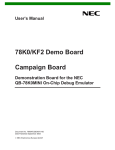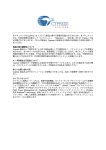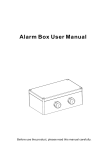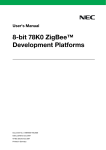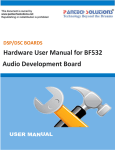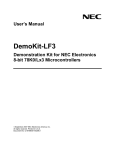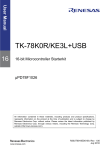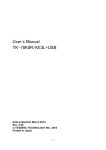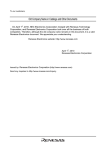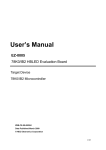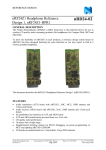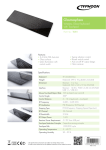Download User`s Manual Release-it ZigBeeTM
Transcript
To our customers, Old Company Name in Catalogs and Other Documents On April 1st, 2010, NEC Electronics Corporation merged with Renesas Technology Corporation, and Renesas Electronics Corporation took over all the business of both companies. Therefore, although the old company name remains in this document, it is a valid Renesas Electronics document. We appreciate your understanding. Renesas Electronics website: http://www.renesas.com April 1st, 2010 Renesas Electronics Corporation Issued by: Renesas Electronics Corporation (http://www.renesas.com) Send any inquiries to http://www.renesas.com/inquiry. Notice 1. 2. 3. 4. 5. 6. 7. All information included in this document is current as of the date this document is issued. Such information, however, is subject to change without any prior notice. Before purchasing or using any Renesas Electronics products listed herein, please confirm the latest product information with a Renesas Electronics sales office. Also, please pay regular and careful attention to additional and different information to be disclosed by Renesas Electronics such as that disclosed through our website. Renesas Electronics does not assume any liability for infringement of patents, copyrights, or other intellectual property rights of third parties by or arising from the use of Renesas Electronics products or technical information described in this document. No license, express, implied or otherwise, is granted hereby under any patents, copyrights or other intellectual property rights of Renesas Electronics or others. You should not alter, modify, copy, or otherwise misappropriate any Renesas Electronics product, whether in whole or in part. Descriptions of circuits, software and other related information in this document are provided only to illustrate the operation of semiconductor products and application examples. You are fully responsible for the incorporation of these circuits, software, and information in the design of your equipment. Renesas Electronics assumes no responsibility for any losses incurred by you or third parties arising from the use of these circuits, software, or information. When exporting the products or technology described in this document, you should comply with the applicable export control laws and regulations and follow the procedures required by such laws and regulations. You should not use Renesas Electronics products or the technology described in this document for any purpose relating to military applications or use by the military, including but not limited to the development of weapons of mass destruction. Renesas Electronics products and technology may not be used for or incorporated into any products or systems whose manufacture, use, or sale is prohibited under any applicable domestic or foreign laws or regulations. Renesas Electronics has used reasonable care in preparing the information included in this document, but Renesas Electronics does not warrant that such information is error free. Renesas Electronics assumes no liability whatsoever for any damages incurred by you resulting from errors in or omissions from the information included herein. Renesas Electronics products are classified according to the following three quality grades: “Standard”, “High Quality”, and “Specific”. The recommended applications for each Renesas Electronics product depends on the product’s quality grade, as indicated below. You must check the quality grade of each Renesas Electronics product before using it in a particular application. You may not use any Renesas Electronics product for any application categorized as “Specific” without the prior written consent of Renesas Electronics. Further, you may not use any Renesas Electronics product for any application for which it is not intended without the prior written consent of Renesas Electronics. Renesas Electronics shall not be in any way liable for any damages or losses incurred by you or third parties arising from the use of any Renesas Electronics product for an application categorized as “Specific” or for which the product is not intended where you have failed to obtain the prior written consent of Renesas Electronics. The quality grade of each Renesas Electronics product is “Standard” unless otherwise expressly specified in a Renesas Electronics data sheets or data books, etc. “Standard”: 8. 9. 10. 11. 12. Computers; office equipment; communications equipment; test and measurement equipment; audio and visual equipment; home electronic appliances; machine tools; personal electronic equipment; and industrial robots. “High Quality”: Transportation equipment (automobiles, trains, ships, etc.); traffic control systems; anti-disaster systems; anticrime systems; safety equipment; and medical equipment not specifically designed for life support. “Specific”: Aircraft; aerospace equipment; submersible repeaters; nuclear reactor control systems; medical equipment or systems for life support (e.g. artificial life support devices or systems), surgical implantations, or healthcare intervention (e.g. excision, etc.), and any other applications or purposes that pose a direct threat to human life. You should use the Renesas Electronics products described in this document within the range specified by Renesas Electronics, especially with respect to the maximum rating, operating supply voltage range, movement power voltage range, heat radiation characteristics, installation and other product characteristics. Renesas Electronics shall have no liability for malfunctions or damages arising out of the use of Renesas Electronics products beyond such specified ranges. Although Renesas Electronics endeavors to improve the quality and reliability of its products, semiconductor products have specific characteristics such as the occurrence of failure at a certain rate and malfunctions under certain use conditions. Further, Renesas Electronics products are not subject to radiation resistance design. Please be sure to implement safety measures to guard them against the possibility of physical injury, and injury or damage caused by fire in the event of the failure of a Renesas Electronics product, such as safety design for hardware and software including but not limited to redundancy, fire control and malfunction prevention, appropriate treatment for aging degradation or any other appropriate measures. Because the evaluation of microcomputer software alone is very difficult, please evaluate the safety of the final products or system manufactured by you. Please contact a Renesas Electronics sales office for details as to environmental matters such as the environmental compatibility of each Renesas Electronics product. Please use Renesas Electronics products in compliance with all applicable laws and regulations that regulate the inclusion or use of controlled substances, including without limitation, the EU RoHS Directive. Renesas Electronics assumes no liability for damages or losses occurring as a result of your noncompliance with applicable laws and regulations. This document may not be reproduced or duplicated, in any form, in whole or in part, without prior written consent of Renesas Electronics. Please contact a Renesas Electronics sales office if you have any questions regarding the information contained in this document or Renesas Electronics products, or if you have any other inquiries. (Note 1) “Renesas Electronics” as used in this document means Renesas Electronics Corporation and also includes its majorityowned subsidiaries. (Note 2) “Renesas Electronics product(s)” means any product developed or manufactured by or for Renesas Electronics. User’s Manual Release-it TM ZigBee -ready Wireless Network Evaluation Board Using the 78K0/KF1+ Microcontroller Hardware Manual Document No. U17586EE1V0UM00 Date Published June 2005 © NEC Electronics Corporation 2005 Printed in Germany [MEMO] 2 UM U17586EE1V0UM00 • The information in this document is current as of May, 2005. The information is subject to change without notice. For actual design-in, refer to the latest publications of NEC Electronics data sheets or data books, etc., for the most up-to-date specifications of NEC Electronics products. Not all products and/or types are available in every country. Please check with an NEC Electronics sales representative for availability and additional information. • No part of this document may be copied or reproduced in any form or by any means without the prior written consent of NEC Electronics. NEC Electronics assumes no responsibility for any errors that may appear in this document. • NEC Electronics does not assume any liability for infringement of patents, copyrights or other intellectual property rights of third parties by or arising from the use of NEC Electronics products listed in this document or any other liability arising from the use of such products. No license, express, implied or otherwise, is granted under any patents, copyrights or other intellectual property rights of NEC Electronics or others. • Descriptions of circuits, software and other related information in this document are provided for illustrative purposes in semiconductor product operation and application examples. The incorporation of these circuits, software and information in the design of a customer's equipment shall be done under the full responsibility of the customer. NEC Electronics assumes no responsibility for any losses incurred by customers or third parties arising from the use of these circuits, software and information. • While NEC Electronics endeavors to enhance the quality, reliability and safety of NEC Electronics products, customers agree and acknowledge that the possibility of defects thereof cannot be eliminated entirely. To minimize risks of damage to property or injury (including death) to persons arising from defects in NEC Electronics products, customers must incorporate sufficient safety measures in their design, such as redundancy, fire-containment and anti-failure features. • NEC Electronics products are classified into the following three quality grades: "Standard", "Special" and "Specific". The "Specific" quality grade applies only to NEC Electronics products developed based on a customerdesignated "quality assurance program" for a specific application. The recommended applications of an NEC Electronics product depend on its quality grade, as indicated below. Customers must check the quality grade of each NEC Electronics product before using it in a particular application. "Standard": Computers, office equipment, communications equipment, test and measurement equipment, audio and visual equipment, home electronic appliances, machine tools, personal electronic equipment and industrial robots. "Special": Transportation equipment (automobiles, trains, ships, etc.), traffic control systems, anti-disaster systems, anti-crime systems, safety equipment and medical equipment (not specifically designed for life support). "Specific": Aircraft, aerospace equipment, submersible repeaters, nuclear reactor control systems, life support systems and medical equipment for life support, etc. The quality grade of NEC Electronics products is "Standard" unless otherwise expressly specified in NEC Electronics data sheets or data books, etc. If customers wish to use NEC Electronics products in applications not intended by NEC Electronics, they must contact an NEC Electronics sales representative in advance to determine NEC Electronics' willingness to support a given application. (Note) (1) "NEC Electronics" as used in this statement means NEC Electronics Corporation and also includes its majority-owned subsidiaries. (2) "NEC Electronics products" means any product developed or manufactured by or for NEC Electronics (as defined above). UM U17586EE1V0UM00 3 4 UM U17586EE1V0UM00 NOTES The information in this document is subject to change without notice. No part of this document may be copied or reproduced in any form or by any means without the prior written consent of NEC Engineering Ltd. and NEC Electronics Corp. NEC Engineering Ltd. and NEC Electronics Corp. assume no liability for infringement of patents or copyrights of third parties by or arising from use of a product described herein. NEC Engineering Ltd. and NEC Electronics Corp. established proven quality assurance procedures for all products manufactured by or on behalf of NEC Engineering Ltd. or NEC Electronics Corp.. As part of product qualification process an intensive release test procedure has been established and executed before the products are released for mass production and delivered to our clients. NEC Engineering Ltd. and NEC Electronics Corp. would like to inform, that the standard quality assurance procedure(s) have not been fully applied to this product and its documentation and that Neither NEC Engineering Ltd. or NEC Electronics Corp. can assure the full and error free function and/or the standard quality level. CAUTION This equipment should be handled like a CMOS semiconductor device. The user must take all precautions to avoid build-up of static electricity while working with this equipment. All test and measurement tool including the workbench must be grounded. The user/operator must be grounded using the wrist strap. The connectors and/or device pins should not be touched with bare hands. UM U17586EE1V0UM00 5 Table of Contents CHAPTER 1 INTRODUCTION ............................................................................................................7 1.1 Features ....................................................................................................................................................7 1.2 Hardware Specifications .........................................................................................................................8 1.3 Interfaces ..................................................................................................................................................9 CHAPTER 2 SWITCHES, JUMPERS, AND LEDS ...........................................................................12 2.1 SW4, SW5, SW7, and JP1......................................................................................................................12 2.1.1 Flash Programming Mode................................................................................................................12 2.1.2 On-chip Debug Mode .......................................................................................................................13 2.1.3 Normal Operation Mode...................................................................................................................13 2.2 SW1 .........................................................................................................................................................14 2.3 SW2 and SW3 .........................................................................................................................................14 2.4 SW6 .........................................................................................................................................................14 2.5 JP2 ..........................................................................................................................................................15 2.6 LED4........................................................................................................................................................15 2.7 LED1, LED2, and LED3 ..........................................................................................................................15 2.8 Jumper on the CC2420EM board..........................................................................................................16 CHAPTER 3 POWER SUPPLY .........................................................................................................17 CHAPTER 4 DESIGN DATA .............................................................................................................18 6 4.1 Parts Layout ...........................................................................................................................................18 4.2 Connection to CC2420EM .....................................................................................................................19 4.3 Circuit Diagram of the MCU Board .......................................................................................................20 4.4 Dimension of the MCU Board ...............................................................................................................23 4.5 Pattern Layout of the MCU Board.........................................................................................................24 4.5.1 Top Side...........................................................................................................................................24 4.5.2 Bottom Side .....................................................................................................................................25 4.5.3 First intermediate layer.....................................................................................................................26 4.5.4 Second intermediate layer ...............................................................................................................27 4.5.5 Third intermediate layer ...................................................................................................................28 4.5.6 Fourth intermediate layer .................................................................................................................29 4.6 BOM List .................................................................................................................................................30 UM U17586EE1V0UM00 CHAPTER 1 INTRODUCTION RELEASE-IT is an evaluation kit for wireless personal area network using 78K0/KF1+ 8-bit MCU and CC2420 RF transceiver. 1.1 • • • • • Features Hardware is ready to accommodate IEEE 802.15.4/ZigBee compliant wireless personal area network with 8 bit single chip MCU 78K0/KF1+, µPD78F0148HD, and 2.4GHz transceiver CC2420. Object code of IEEE 802.15.4 PHY/MAC is included in the kit and possible to utilize as a library. 60 Kbytes of Flash EEPROM, available on chip in the 78K0/KF1+ MCU, is programmable from PC via USB connection without any additional Flash programming hardware Debugging of the program can be made from PC via USB connection utilizing the debugger included in the kit without any additional debugging hardware. The evaluation version of the IAR Embedded Workbench for 78K0/K0S, containing C Compiler, Assembler, Linker and C-SPY Simulator can be downloaded from the IAR webpage http://www.iar.com. The direct link to the webpage to download the evaluation version for 78K0/K0S is: http://wwwjobb4.iar.se/Download/SW/?item=EW78K-EVAL • • • • • • • USB connection can be utilized not only for Flash programming and debugging, but also for user applications and power supply. Real time clock is available on the board. Two MCU boards and two RF transceiver boards with two antennas are packaged in the kit. Two digital input ports, two digital output ports, and three analog input ports are available in the each of the MCU board. Two tact switches and one 5-direction tact switch are on board in addition to one hardware reset switch. Four green LEDs are available on board. Two battery adapters for 006P are included in the kit. UM U17586EE1V0UM00 7 CHAPTER 1 1.2 INTRODUCTION Hardware Specifications MCU: µPD78F0148HD x 2 Main Clock: 16 MHz Real Time Clock: 32.768 KHz RF Transceiver: Chipcon CC2420, one each on two CC2420EM boards Please refer to www.chipcon.com for further details Antenna: Two Titanis made by Gigaant, www.gigaant.com, one each on the CC2420EM board. Interfaces: USB Mini B Connector between the MCU board and the CC2420EM RF board I/O Expansion of two digital input ports, two digital output ports, and three analog input ports CNB connector for Temp/Humid sensor, SHT11 made by Sensirion, www.sensirion.com/ A battery connector with an adapter for a 006P battery per board Power Supply: 5V by USB or 9V (Min. 6.5V) by battery connector Current consumption: Max. 150mA @5V Actual consumed current depends on the amount data of TX and/or RX, and mode settings of the transceiver Operation Environment: Temperature: 0 – 40 deg C Humidity: less than 80 % Dimension: 8 MCU Board: 70mm x 60mm RF Board: 40mm x 30mm Assembled: 80mm x 60mm x 83 mm (H) with an antenna UM U17586EE1V0UM00 CHAPTER 1 INTRODUCTION Interfaces 1.3 I/O Expansion, CN3, HONDA CONNECTORS FFC-10BMEP1 CN3 Name MCU PIN Description 1 N.C. 2 P140 P140/PCL/INTP6 Input to MCU with 4.7KΩ Pull-up 3 P10 P10/SCK10/TXD0 Output from MCU with 4.7KΩ Pull-up 4 P11 P11/SI10/RXD0 Input to MCU with 4.7KΩ Pull-up 5 GND GND 6 P12 P12/SO10 Output from MCU with 4.7KΩ Pull-up 7 P24 P24/ANI4 Analog input to MCU with 1MΩ Pull-up 8 P25 P25/ANI5 Analog input to MCU with 1MΩ Pull-up 9 P26 P26/ANI6 Analog input to MCU with 1MΩ Pull-up 10 GND GND 1pin 2pin 9pin 10pin Edge of the board CN3 Pin Configuration Connector to the RF Board (1/2), CN6, SAMTEC TFM-110-02-S-D-A-K-TR CN6 Name MCU Pin 1 GND GND Description 2 3 N.C. VREG_EN P02/SO11 Output from MCU 4 N.C. 5 RESn P03/SI11 Output from MCU 6 FIFO P33/TI51/TO50/INTP4 Input to MCU 7 8 N.C. FIFOP P30/INTP1 Input to MCU 9 10 N.C. CCA P62 Input to MCU 11 12 13 N.C. SFD P06/TI011/TO01 Input to MCU N.C. UM U17586EE1V0UM00 9 CHAPTER 1 14 CSn P145/STB0 Output from MCU 15 16 INTRODUCTION N.C. SCLK P142/SCKA0 Output from MCU 17 N.C. 18 SI P144/SOA0 19 GND GND 20 SO P143/SIA0 Output from MCU Input to MCU Connector to the RF Board (2/2), CN7, SAMTEC TFM-110-02-S-D-A-K-TR CN6 Name 1 TP2 2 GND 3 TP2 4 GND 5 TP2 6 GND 7 3.3V 8 GND 9 3.3V 10 GND 11 TP3 12 GND 13 TP4 14 GND MCU Pin Description GND GND GND GND GND GND GND 15 16 N.C. GND GND 17 18 N.C. GND GND 19 20 N.C. GND GND 1pin 2pin 1pin 2pin CN7 CN6 19pin 20pin 19pin 20pin PIN Configuration of CN6 and CN7 10 UM U17586EE1V0UM00 CHAPTER 1 INTRODUCTION Connector to Temp/Humid Sensor, CN8, MAC8 HDB-1-1-4P CN8 Name MCU Pin Description 1 SCK P04/SCK11 Output from MCU 2 VDD VDD 5.0V 3 GND GND 4 DATA P05/SSI11/TI001 Input/Output with MCU 1pin Board Edge 4pin CN8 Pin Configuration UM U17586EE1V0UM00 11 CHAPTER 2 SWITCHES, JUMPERS, AND LEDS 2.1 SW4, SW5, SW7, and JP1 SW4 and SW5 are a DIP switch to select an operation mode. SW7 is a slide switch to select an operation mode. JP1 is a jumper to select a power source. 2.1.1 Flash Programming Mode Flash EEPROM on the 78K0/KF1+ MCU can be programmed using the attached software “PG-FPL” in your PC, which is connected to the MCU board via USB cable, if the following switch and jumper setting is made. Flash Programming Mode SW4 12 Bit 1 OFF Bit 2 OFF Bit 3 OFF Bit 4 OFF SW5 ON SW7 UART JP1 USB UM U17586EE1V0UM00 CHAPTER 2 2.1.2 SWITCHES, JUMPERS, AND LEDS On-chip Debug Mode The following setting activates the On-chip debug functions on the MCU. You can debug your program code in the Flash EEPROM, if your PC is connected to the MCU board via USB. On-chip debug mode SW4 2.1.3 Bit 1 ON Bit 2 ON Bit 3 ON Bit 4 ON SW5 ON SW7 OCD JP1 USB Normal Operation Mode SW4 Bit 1 OFF Bit 2 OFF Bit 3 OFF Bit 4 OFF SW5 OFF SW7 UART JP1 See below Selection of power source by JP1 USB Power USB (Pin 1) Battery CN2 (Pin 3) UM U17586EE1V0UM00 13 CHAPTER 2 SWITCHES, JUMPERS, AND LEDS SW1 2.2 SW1is a 4 directional switch with center push. If it is directed or pushed, the P7*/KR* input is set to GND. Otherwise the circuit is open. Therefore please set the on-chip pull-up resistors at P7*/KR* during initializing routine of your program code. For more detail, please refer to the User’s manual of the µPD78F0148HD MCU. 4-directional/center-push switch SW1, ALPS SKRHADE010 SW1 Name MCU Pin Description 1 P72 P72/KR2 UP 2 P73 P73/KR3 CENTER PUSH 3 P74 P74/KR4 LEFT 4 P75 P75/KR5 RIGHT 5 GND GND 6 P76 P76/KR6 DOWN UP LEFT RIGHT Board Edge Docume SW1 Date Pu 2.3 SW2 and SW3 SW2 and SW3 are tact switches. The port inputs are short-circuited to ground, while they are being pushed, and kept open otherwise. Therefore please set the on-chip pull-up resistors at the ports during initializing routine of your program code. For more detail, please refer to the User’s manual of the µPD78F0148HD MCU. Tact switches SW2 and SW3, ALPS SKQMBBE010 Name 2.4 MCU Pin SW2 P70 P70/KR0 SW3 P71 P71/KR1 Description SW6 SW6 is the hardware reset. 14 UM U17586EE1V0UM00 CHAPTER 2 2.5 SWITCHES, JUMPERS, AND LEDS JP2 JP2 defines the signal level, 5V or 3.3V, of the I/O expansion, CN3. JP2 Settings 2.6 5.0V Marked as 5.0V: Pin 1 3.3V Marked as 3.3V: Pin 3 LED4 LED4 is the power indicator. 2.7 LED1, LED2, and LED3 LED1, LED2, and LED3 are available for applications. To make an LED on, please set the output port LOW. LED1, LED2, and LED3: STANLEY ELECTRIC: PG1111C Name MCU Pin Description LED1 P40 P40/AD0 LED is ON, while P40 is LOW. LED2 P41 P41/AD1 LED is ON, while P41 is LOW. LED3 P42 P42/AD2 LED is ON, while P42 is LOW. LED4 LED1 LED2 Board Edge LED3 LED1, LED2, LED3, and LED4 UM U17586EE1V0UM00 15 CHAPTER 2 2.8 SWITCHES, JUMPERS, AND LEDS Jumper on the CC2420EM board Please set the jumper on the CC2420EM board as shown in the schematic below. For details of the CC2420EM board, please contact Chipcon AS at www.chipcon.com. 16 UM U17586EE1V0UM00 CHAPTER 3 POWER SUPPLY There are two choices to supply power to the board, USB or a 006P battery via CN2. Please refer to 2.1.3 JP1 for the jumper setting. Please replace the battery with a new one, if the voltage level goes down to 6.5V. Below the voltage level of 6.5V, functions of the board are not guaranteed. The battery voltage can be checked at the port P20 as shown below. Battery Check Name MCU Pin BT_MONI P20/ANI0 Description 33.8% of the battery output is available at ANI0. For instance, if the battery level is 9 V, the level of the BT_MONI = 0.338×9.0 V = 3.042 V If the battery level is 6.5 V, the level of the BT_MONI = 0.338×6.5 V = 2.197 V UM U17586EE1V0UM00 17 CHAPTER 4 DESIGN DATA 4.1 18 Parts Layout UM U17586EE1V0UM00 CHAPTER 4 4.2 DESIGN DATA Connection to CC2420EM UM U17586EE1V0UM00 19 CHAPTER 4 4.3 20 Circuit Diagram of the MCU Board UM U17586EE1V0UM00 DESIGN DATA CHAPTER 4 UM U17586EE1V0UM00 21 DESIGN DATA CHAPTER 4 22 UM U17586EE1V0UM00 DESIGN DATA CHAPTER 4 4.4 DESIGN DATA Dimension of the MCU Board UM U17586EE1V0UM00 23 CHAPTER 4 4.5 Pattern Layout of the MCU Board 4.5.1 Top Side 24 DESIGN DATA UM U17586EE1V0UM00 CHAPTER 4 4.5.2 DESIGN DATA Bottom Side UM U17586EE1V0UM00 25 CHAPTER 4 4.5.3 26 DESIGN DATA First intermediate layer UM U17586EE1V0UM00 CHAPTER 4 4.5.4 DESIGN DATA Second intermediate layer UM U17586EE1V0UM00 27 CHAPTER 4 4.5.5 28 DESIGN DATA Third intermediate layer UM U17586EE1V0UM00 CHAPTER 4 4.5.6 DESIGN DATA Fourth intermediate layer UM U17586EE1V0UM00 29 CHAPTER 4 4.6 30 DESIGN DATA BOM List UM U17586EE1V0UM00
































